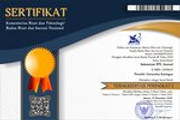STORY AND SONG IN TEACHING ENGLISH TO YOUNG INDONESIAN EFL LEARNERS: HOW POWERFUL?
Abstract
To children especially, song and story bring a lot of joys and happiness. How far children can understand the meaning of vocabularies contained in a song and a story will depend mainly on the pattern of cohesiveness of both text genres and this is the main concern of this study. One story and one song were chosen—they were judgmentally selected regarding that: 1) they were favored by 3 English teachers in elementary schools to be taught in their class; 2) they were listed in the textbooks used by those three teachers. 30 children aged 10 were chosen as the participants of this study. The discourse patterns of cohesion (reference, lexical relations, conjunctive relations, and conversational structure) served as a tool of analysis and were applied to both song and story in order to figure out the semantic unity of both texts. This research revealed that: 1) presuming references were found more in story meanwhile presenting references were recognized more in song; 2) classification and composition were found more in story and contrast feature was found in song; 3) conjunctive reticulum for the story shows more for internal relations while song shows the opposite; 4) the choice of speech function and type of exchange structure are displayed more clearly in story than in song. These results lead to a conclusion that in understanding vocabularies contained in both texts; children show conceptual and metalinguistic knowledge more in understanding the story and expose their interest, joyful and happiness while learning song.
Keywords: reference, lexical relations, conjunctive relations, conversational structure, semantic unity, conceptual, metalinguistic.
Keywords: reference, lexical relations, conjunctive relations, conversational structure, semantic unity, conceptual, metalinguistic.
Full Text:
PDFDOI: https://doi.org/10.25134/ieflj.v1i1.615
Refbacks
- There are currently no refbacks.

This work is licensed under a Creative Commons Attribution-ShareAlike 4.0 International License.

